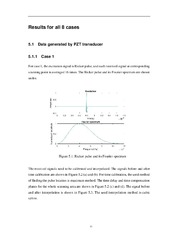| dc.contributor.advisor | Melandsø, Frank | |
| dc.contributor.author | Peng, Chengxiang | |
| dc.date.accessioned | 2019-07-08T13:57:49Z | |
| dc.date.available | 2019-07-08T13:57:49Z | |
| dc.date.issued | 2019-05-30 | |
| dc.description.abstract | Degeneration of articular cartilage is known as a serious and painful knee disease seriously affecting people in all ages. The disease also marks the presence of osteoarthritis which is a complex musculoskeletal disorder. A successful assessment of the degeneration status is of great importance for estimating osteoarthritis progression, and thereby beneficial for implementing clinical treatments. Ultrasound has played a vital role in imaging the articular cartilage since it is capable of providing distinct information of important cartilage structures. However, various types of noise in ultrasound signals (e.g. clutter noise) are known to limit the quality of ultrasound images, especially at high frequencies where wave attenuation becomes severe. The possibility for improving the signal to noise ratio (SNR) by using coded signals is therefore the motivation behind this thesis, with the main objective is to investigate suitable codes and compression methods for cartilage imaging.
The main focus of this thesis has been put on coded ultrasound signals and related signal processing methods. Transducers made from two different piezoelectric materials (PZT and PVDF) are used to image a thick cartilage sample. For each transducer, three different waveforms (Ricker wavelet, Gaussian chirped, and a 13-bit Barker) are used to excite the ultrasonic transducers. Two different wave compression methods (Matched filtering and Wiener filtering) are also explored to decode the signals received by transducers. Ahead of processing the received signals, a time calibration was used to compensate for sample tilting, yielding an improved precision in the phase/time delay. A maximum method and a center of mass method were used for calibration.
The results from the experimental work show that both Chirp coded signals and Barker coded signals work well in improving the SNR, and that both transducers are able to produce high quality images of the cartilage sample. For the situations using coded excitation signals, however, the PZT transducer has high requirement for excitation repetition frequency because of its built-in delay line. Different time calibration methods have their own applicable conditions. Matched filter and Wiener filter both perform well for decoding, but the “noise” parameter in the Wiener filter has to be adjusted carefully to produce reasonable results. | en_US |
| dc.identifier.uri | https://hdl.handle.net/10037/15731 | |
| dc.language.iso | eng | en_US |
| dc.publisher | UiT Norges arktiske universitet | en_US |
| dc.publisher | UiT The Arctic University of Norway | en_US |
| dc.rights.accessRights | openAccess | en_US |
| dc.rights.holder | Copyright 2019 The Author(s) | |
| dc.rights.uri | https://creativecommons.org/licenses/by-nc-sa/4.0 | en_US |
| dc.rights | Attribution-NonCommercial-ShareAlike 4.0 International (CC BY-NC-SA 4.0) | en_US |
| dc.subject.courseID | FYS-3900 | |
| dc.subject | VDP::Mathematics and natural science: 400::Physics: 430::Electromagnetism, acoustics, optics: 434 | en_US |
| dc.subject | VDP::Matematikk og Naturvitenskap: 400::Fysikk: 430::Elektromagnetisme, akustikk, optikk: 434 | en_US |
| dc.subject | VDP::Mathematics and natural science: 400::Information and communication science: 420::Simulation, visualization, signal processing, image processing: 429 | en_US |
| dc.subject | VDP::Matematikk og Naturvitenskap: 400::Informasjons- og kommunikasjonsvitenskap: 420::Simulering, visualisering, signalbehandling, bildeanalyse: 429 | en_US |
| dc.subject | VDP::Technology: 500::Electrotechnical disciplines: 540::Electronics: 541 | en_US |
| dc.subject | VDP::Teknologi: 500::Elektrotekniske fag: 540::Elektronikk: 541 | en_US |
| dc.title | Coded Signals for High Frequency Ultrasound Imaging | en_US |
| dc.type | Master thesis | en_US |
| dc.type | Mastergradsoppgave | en_US |


 English
English norsk
norsk

